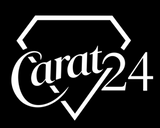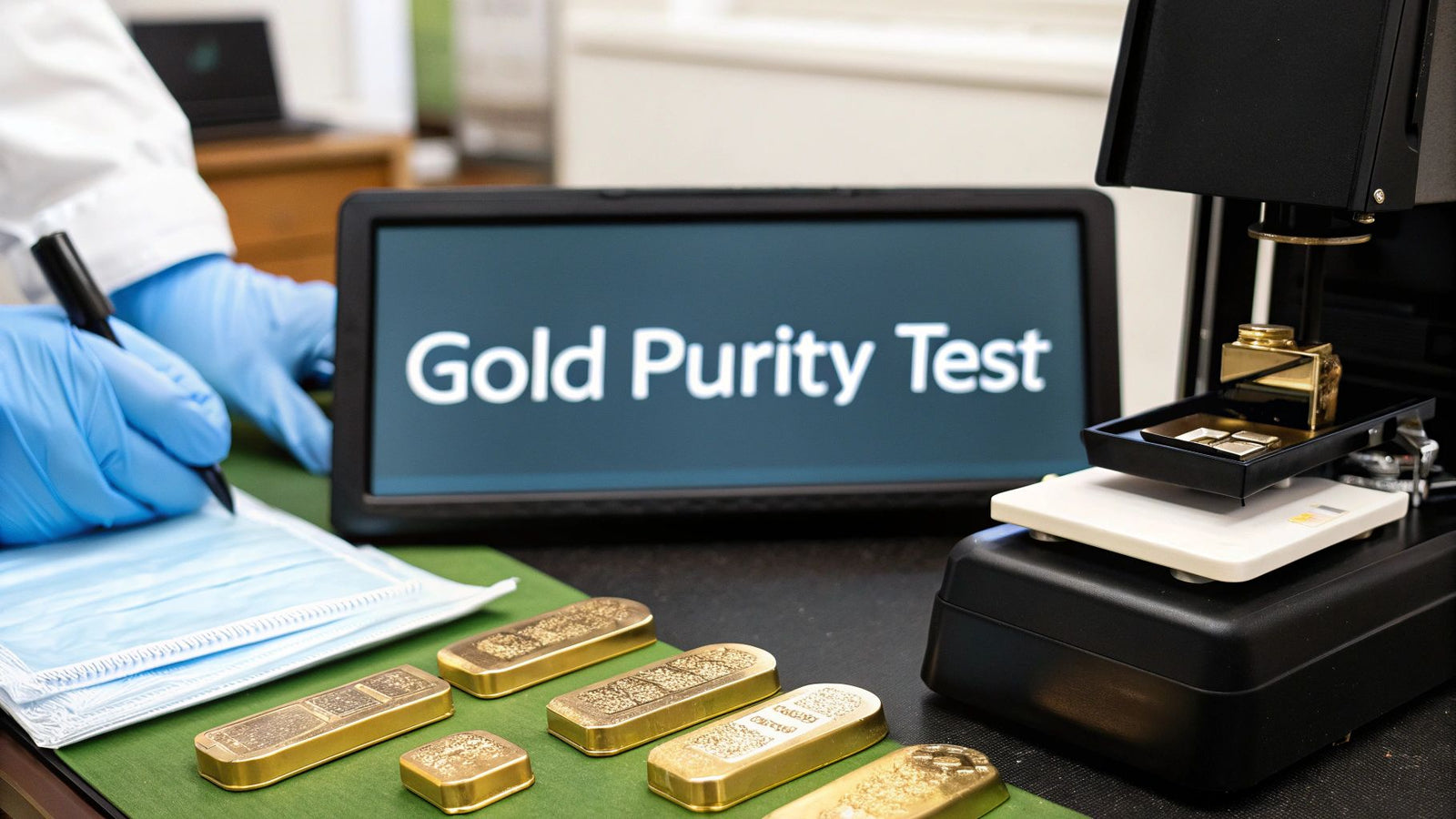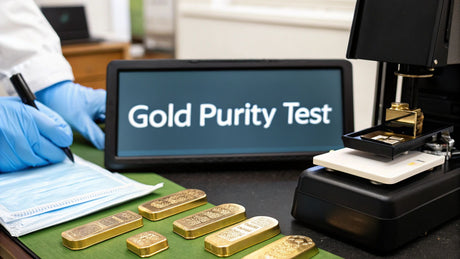Before you even think about testing a piece of gold, you've got to know what you're looking for. The whole process really boils down to two approaches: quick, at-home methods like the magnet test for a first pass, and professional evaluations like X-Ray scanning for dead-on accuracy.
But before any of that, the real first step is decoding the little numbers and letters stamped onto the gold itself. Understanding what markings like '14K' or '750' actually mean is foundational. This knowledge is what turns a confusing jumble of results into a clear picture of what you have.
Decoding Gold Purity Before You Test
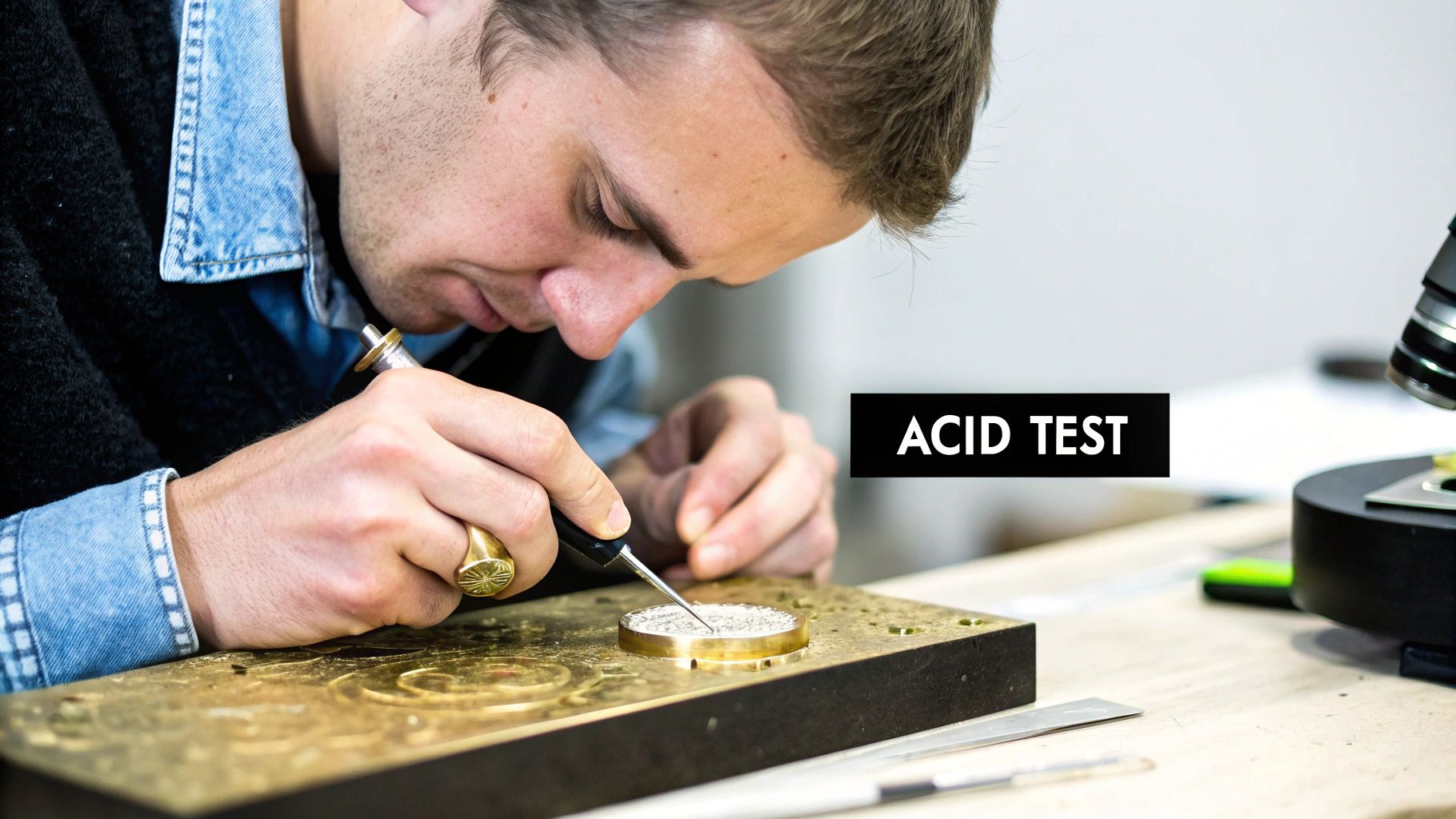
Jumping into a test without knowing the language of gold is like trying to read a map without a key. The terms might seem a bit technical at first, but they’re your primary clues to an item's potential value. Getting a handle on this is your ticket to making smart decisions, whether you're sorting through a family heirloom or thinking about selling some old jewelry for the highest payout in Boise.
Understanding Karats and Fineness
The most common way we talk about gold purity is in karats, usually shortened to 'K' or 'KT'. Pure, unadulterated gold is 24 karat (24K). The thing is, 24K gold is incredibly soft—too soft, really, for pieces you want to wear every day. To make it durable enough to withstand daily life, it’s mixed with other metals to create an alloy.
Here’s a quick breakdown of what you’ll commonly see:
- 18K Gold: This means the item is 18 parts gold and 6 parts other metals, making it 75% pure gold.
- 14K Gold: This popular choice is 14 parts gold and 10 parts other metals, or 58.3% pure gold.
- 10K Gold: This is the minimum legal standard for gold in the U.S. It consists of 10 parts gold and 14 parts other metals, for a purity of 41.7%.
You'll also run into the term fineness. It's just another way of measuring purity, but this time in parts per thousand. For example, that same 18K gold piece would be marked '750' because it's 750 parts gold out of 1000. These stamps, called hallmarks, are usually tucked away in a discreet spot, like the inside of a ring's band or on a necklace clasp.
To make this crystal clear, here's a simple chart you can reference.
Gold Karat and Fineness Conversion Chart
| Karat (K) | Gold Percentage (%) | Fineness (Parts per 1000) |
|---|---|---|
| 24K | 99.9% | 999 |
| 22K | 91.7% | 917 |
| 18K | 75% | 750 |
| 14K | 58.3% | 583 |
| 10K | 41.7% | 417 |
Think of this table as your quick-glance guide for translating the markings you find on your jewelry into a clear percentage of pure gold.
Key Takeaway: A hallmark is a fantastic starting point, but it isn't an ironclad guarantee of purity. For a truly definitive answer, professional Gold Testing for free with methods like Xray Scanning is the most reliable way to go.
Why Alloys Matter
Those other metals mixed in with the gold—like copper, silver, zinc, and nickel—aren't just there to take up space. They serve a real purpose. They provide the strength and resilience needed for jewelry to survive daily wear and tear.
They also play a huge role in the gold's final color. For instance, adding more copper is what gives rose gold its warm, pinkish hue. Alloys like palladium or nickel are used to create the sleek, silvery look of white gold. The specific blend of these metals can vary, and some regions are famous for their unique alloy recipes. If you're curious about that, you can dive deeper into the craftsmanship of specific styles in our guide on what is Italian gold.
Ultimately, knowing these basics puts you in the driver's seat. It helps you quickly sort through items and prepares you to save the hassle and sell locally for more than online shipments. When you're ready, a trusted expert specializing in Gold and Jewelry Buying can give you a hassle-free offer based on transparent, accurate testing.
Quick At-Home Tests for Sorting Your Jewelry
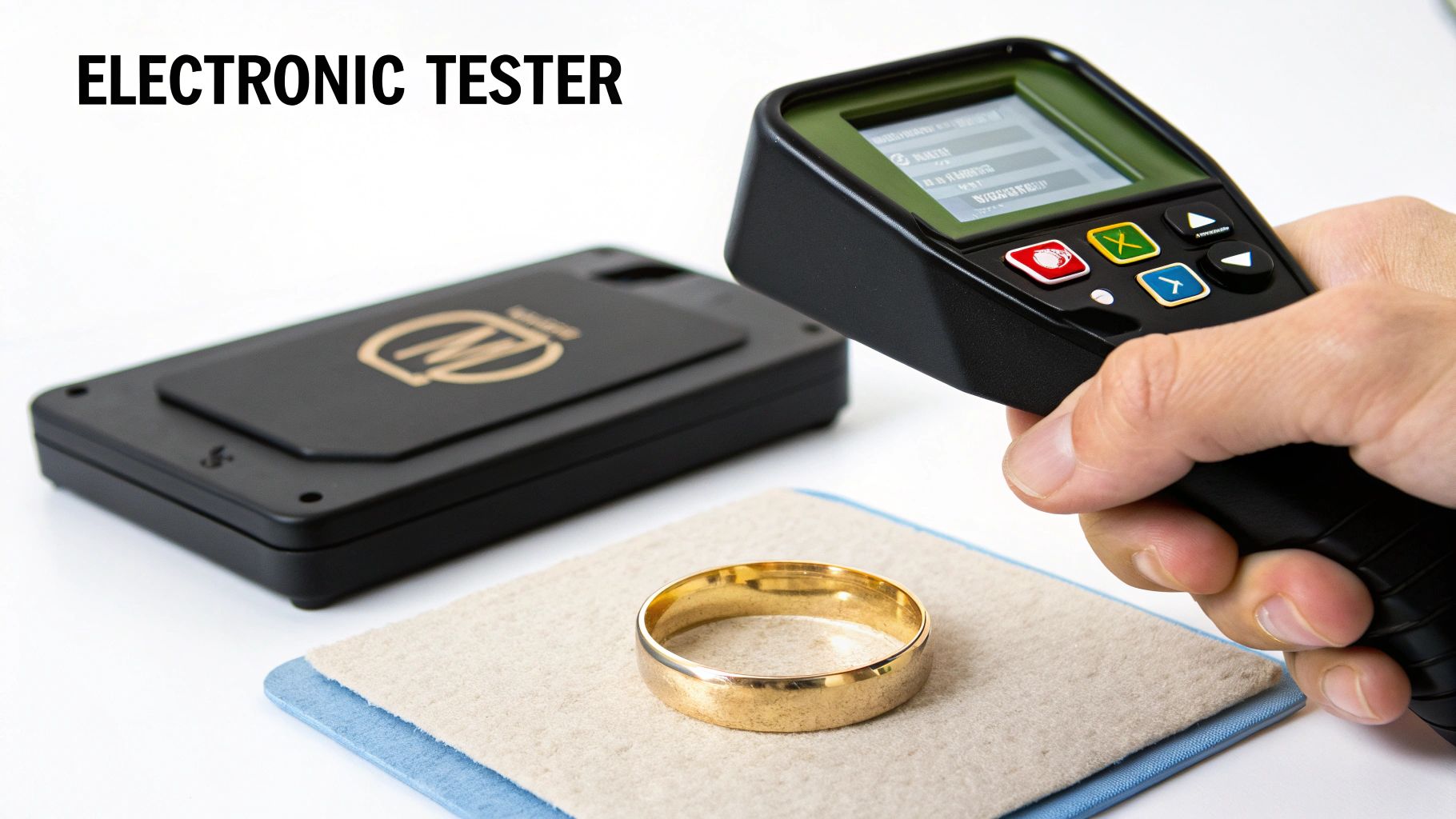
If you have a jewelry box filled with heirlooms and forgotten pieces, you don't need a fancy lab to start figuring out what’s what. A few simple at-home checks can help you sort the real treasures from the costume jewelry pretty quickly.
Think of these methods as a first pass, a way to organize your collection before you bring it in for a professional opinion and a hassle-free offer. They’re non-destructive, require things you probably already have, and can save you a ton of time down the road.
The Instant Magnet Test
This is one of the fastest ways to weed out potential fakes. Why? Because gold is not magnetic. Grab a strong magnet—something more powerful than your average refrigerator souvenir—and hold it right up to your jewelry.
If you feel a pull or the item snaps right to the magnet, you can be pretty confident it's not solid gold. Many counterfeit pieces hide an iron or steel core, both of which are highly magnetic. But keep in mind, this test isn't 100% foolproof.
For example, the clasp on a genuine gold necklace might have a tiny steel spring inside, which will react to the magnet. Always test the main body of the piece, like the chain itself, not just the clasp, to get an accurate read.
The Ceramic Scratch Test
Here’s another straightforward test you can do at home. Find an unglazed ceramic plate or tile. The rough ring on the bottom of many coffee mugs or plates works perfectly for this. Gently rub a small, out-of-the-way spot on your jewelry across that ceramic surface.
- A golden or yellowish streak is a good sign—it suggests the item is likely real gold.
- A black or gray streak means the piece is probably not gold, or at best, it's only thinly gold-plated.
This test is more revealing than the magnet test, but it does come with a small risk of scratching. I always recommend using a spot that won't be visible when you're wearing it. While this is a great DIY method, remember it's only testing the surface metal. You can find more detailed ways to spot fakes in our guide on how to identify fake gold.
The Ancient Touchstone Method
This is one of the oldest tricks in the book, with roots stretching back to ancient Egypt between 2600 and 1900 BC. It involves rubbing the gold item on a special dark stone, called a touchstone, to leave a streak. That streak is then tested with specific acids and compared to streaks made by gold of a known purity. You can learn more about the history of gold purity testing on lbma.org.uk.
These at-home tests are a great starting point, but they can't provide the definitive accuracy of professional methods. They are best used to weed out obvious fakes and organize your collection.
Ultimately, to get the highest payout in Boise, you'll want a conclusive analysis. After sorting your items, bringing them to us for a professional, free Xray Scanning is the best way to confirm their exact purity. This ensures you can save the hassle and sell locally for more than online shipments, knowing you're getting a fair and accurate price.
Getting Accurate Results with Professional Testing
While at-home tests are a fantastic first step for sorting through your pieces, they have their limits. When you absolutely need a definitive, accurate answer about your gold's purity, turning to a professional is the only real option.
These advanced methods go far beyond simple observation, using specialized equipment to give you a precise analysis. For anyone serious about understanding the true value of their items—especially before selling—this is the most important step you can take. It’s the difference between guessing and knowing for sure.
The Gold Standard: X-Ray Fluorescence (XRF) Scanning
The pinnacle of modern, non-destructive gold testing is X-Ray Fluorescence, or XRF scanning. This is the exact technology that reputable jewelers and expert gold buyers like us rely on for its incredible speed and pinpoint accuracy.
So, how does it work? An XRF scanner bombards the item with safe, low-energy X-rays. This excites the atoms within the metal, causing each element to emit its own unique energy signature. The scanner reads these signatures and, in a matter of seconds, gives us a detailed breakdown of the item’s complete elemental composition. It doesn't just tell you the karat; it can identify every single metal in the alloy, from silver and copper to platinum and zinc.
XRF analysis has become the go-to method in high-value markets across the United States, Europe, and Asia. Since becoming widely available in the late 20th century, this non-destructive technique has proven its worth. Modern portable XRF machines can analyze everything from 8K to 24K gold without leaving so much as a scratch, making the technology perfect for jewelers, refineries, and assay offices worldwide.
Other Professional Testing Methods
While XRF is our preferred method for customer-facing evaluations—thanks to its safety and transparency—a few other professional techniques exist. Each has its place, but they all come with certain trade-offs.
- Electronic Testers: These devices send a small electrical current through the metal to measure its resistance. While they're faster and less messy than old-school acid tests, their accuracy can be thrown off by surface plating or even minor contamination.
- The Fire Assay: This is, without a doubt, the most accurate method available. However, it’s also completely destructive. The process involves melting down a sample of the gold to separate the pure metal from its alloys. Because it destroys the item, this method is reserved for refineries and mints, not for appraising your finished jewelry.
The infographic below gives a great visual of another professional method—the density check—which relies on a precision scale and water displacement.
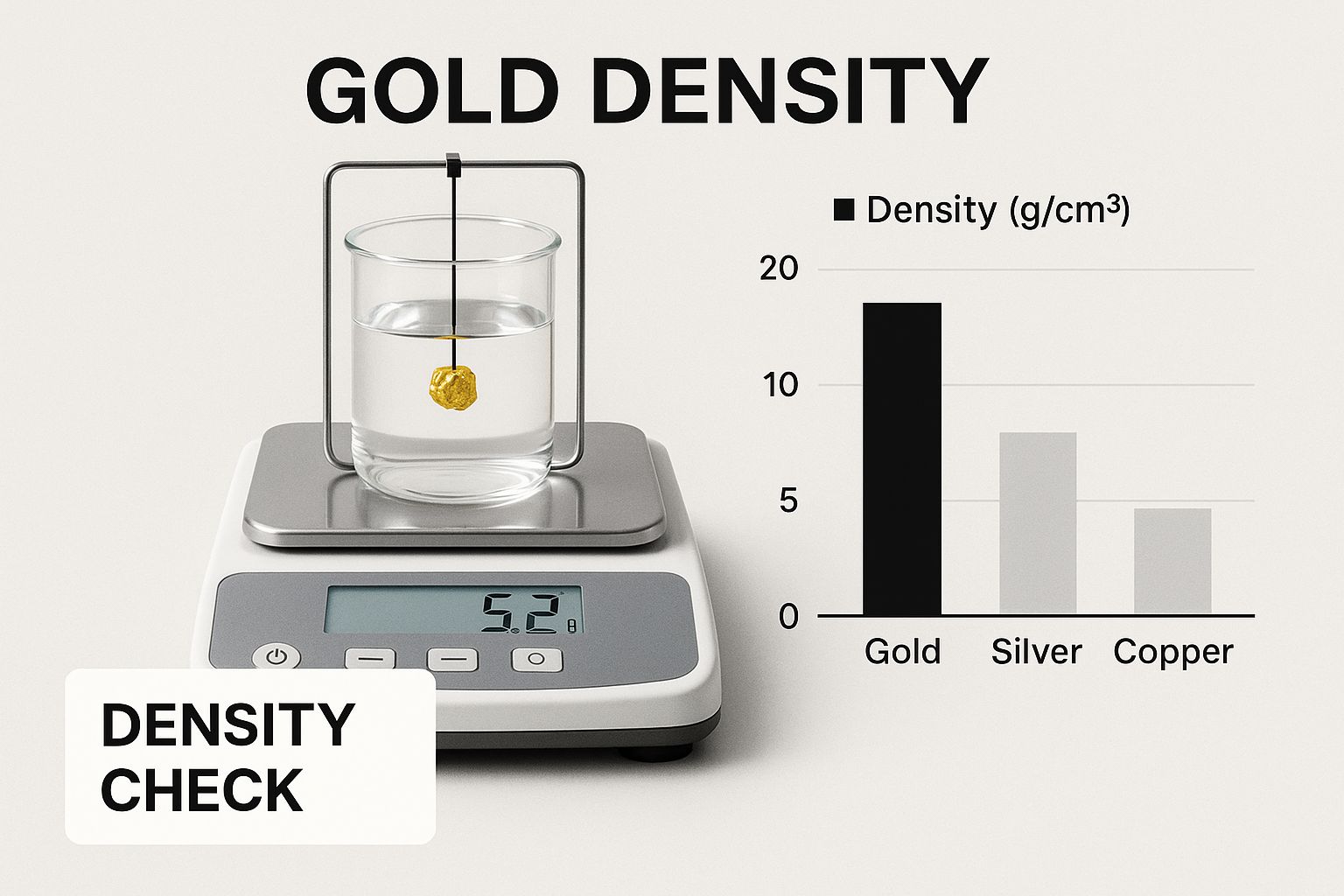
This setup shows how comparing an item's weight in air to its weight submerged in water reveals its density—a key clue to its gold content.
When it comes to weighing the pros and cons, each professional method serves a different purpose. Here’s a quick breakdown to help you understand why we almost always recommend an XRF scan for jewelry.
Comparing Professional Gold Testing Methods
| Method | Accuracy | Speed | Destructive? | Best For |
|---|---|---|---|---|
| XRF Scan | Very High (99%+) | Very Fast (Seconds) | No | Appraising finished jewelry, coins, and bullion |
| Electronic Tester | Moderate | Fast (Seconds) | No | Quick initial checks on unplated items |
| Fire Assay | Extremely High | Slow (Hours/Days) | Yes | Refineries, mints, and scientific analysis |
| Density Check | Good | Moderate | No | Solid items without stones or hollow parts |
As you can see, the XRF scan hits the sweet spot of high accuracy and speed without any risk to your items.
Expert Insight: For everyday Gold and Jewelry Buying, the XRF scan is simply superior. It delivers near-perfect accuracy without harming your cherished pieces, providing a transparent and hassle-free offer you can see and trust.
Ultimately, knowing exactly what you have is the first step toward making a smart financial decision. To learn more about the entire valuation process, check out our guide on what to expect from a jewelry appraisal near me. This knowledge ensures you can save the hassle and sell locally for more than online shipments, backed by precise, professional testing.
Why a Local Buyer Beats Mail-In Services
So, you’ve done your homework and have a good idea of what your gold is worth. Now comes the big question: where do you sell it? You've probably seen ads for mail-in gold services promising a quick and easy process. But in my experience, that convenience often comes with a hefty price—hidden risks, lower payouts, and a whole lot of stress.
There’s a much smarter, safer, and more profitable way to go: a face-to-face transaction with a trusted local expert.
Choosing a local professional for your Gold and Jewelry Buying needs puts you firmly in the driver's seat. You never have to drop your valuables into a mailbox, cross your fingers, and just hope for the best. You're in control from start to finish.
The Power of In-Person Transparency
One of the biggest wins of selling locally is the simple, powerful act of seeing everything with your own eyes.
When you walk into a reputable buyer here in Boise, you get to watch the entire evaluation happen right in front of you. That includes complimentary Xray Scanning and Gold Testing for free, which gives a precise, on-the-spot breakdown of your jewelry's exact composition.
This immediate verification eliminates all the guesswork and anxiety. There's no wondering if your package arrived safely or if your items are being tested accurately behind some closed door hundreds of miles away. You see the results, and you can talk them over with an expert right then and there. This leads directly to hassle-free offers based on real, verifiable data.
When you save the hassle and sell locally for more than online shipments, you're not just getting a better price. You're getting a secure and transparent experience. The peace of mind that comes from never letting your valuables out of your sight is invaluable.
Maximizing Your Payout with Confidence
Local buyers have a reputation to uphold in their own community, and that accountability almost always means better offers for you. We’re committed to providing the highest payout in Boise and will even offer Price Matching to make sure you walk away with the best possible value for your gold.
Good luck finding that level of personal commitment from an anonymous online company.
When you ship your gold to a faceless business, you give up all your leverage. You're often stuck with their first, non-negotiable offer. If you're serious about finding the best place to sell gold, selling locally is the only way to go. You can compare offers confidently and walk away with cash in your hand that same day. It's simply faster, safer, and a much more rewarding way to turn your unwanted jewelry into a real payout.
Common Mistakes in Gold Testing and Selling
When you're looking to test or sell your gold, a few common slip-ups can really take a bite out of your final payout. It's a path many have walked, and I've seen the same missteps time and again.
One of the biggest is putting all your faith in stamped hallmarks or a quick at-home test. A "14K" stamp feels reassuring, but unfortunately, counterfeiters are good at their jobs and can easily stamp fake jewelry. That hallmark is a good starting point, not the final word.
Likewise, relying on just one DIY method, like the magnet or scratch test, can lead you astray. These are fantastic for a quick sort, but they won't tell you the difference between solid gold and heavy gold plating. That's a mistake that could easily cost you hundreds of dollars.
Damaging Your Valuables Unnecessarily
Another pitfall I see all too often is people accidentally damaging their own jewelry. An aggressive scratch test or using harsh chemicals on a sentimental or high-end piece can permanently devalue it. A deep gash on a designer ring or a chemical stain on a family heirloom pretty much ruins its potential to be sold as a finished piece.
Before you even think about a destructive test, take a moment and ask yourself: does this item have value beyond its raw metal?
The real goal here is to figure out the purity without wrecking the item's aesthetic or sentimental worth. A non-destructive, professional Xray Scanning and Gold Testing for free is by far the safest and most accurate way to protect your assets while getting a crystal-clear understanding of their value.
Leaving Money on the Table
Maybe the most critical mistake of all is just taking the first offer that comes your way. Selling gold isn't just about the purity test; it's about getting the best possible price for what you have. I've heard stories of people, especially those who use mail-in services, feeling pressured to accept a lowball offer simply because sending it back is a hassle. You can get a better handle on what your items might be worth by checking out our guide on what is my gold worth.
To walk away with the highest payout in Boise, you absolutely need to get hassle-free offers from a trusted local buyer who stands behind their service with things like Price Matching.
When you save the hassle and sell locally for more than online shipments, you stay in control. You get to watch the testing process firsthand and negotiate with confidence. Steering clear of these common mistakes is the key to a secure, transparent, and profitable Gold and Jewelry Buying experience.
Your Gold Purity Testing Questions Answered
Navigating the world of gold can stir up a lot of questions. Whether you're sorting through a family estate or just curious about a piece you've owned for years, getting clear, direct answers is what matters. We've put together some straightforward responses to the most common queries we hear from folks just like you.
What Is the Most Reliable Way to Test My Gold for Free?
The single most reliable—and accurate—method that won't cost you a dime is to visit a reputable local expert who offers complimentary Xray Scanning and Gold Testing for free.
An X-Ray Fluorescence (XRF) scan is completely non-destructive, meaning it won't harm your jewelry in any way. In just a few seconds, it provides a precise breakdown of the item's metallic composition. This takes all the guesswork out of at-home tests and gives you a definitive answer on your gold's karat value, with no cost or obligation. It's truly a cornerstone of professional Gold and Jewelry Buying.
Can I Trust the Karat Stamp on My Jewelry?
While hallmarks and karat stamps (like '14K' or '750') are generally good starting points, you shouldn't trust them blindly. It's an unfortunate reality, but counterfeiters can easily stamp fake jewelry with marks that look completely authentic.
Always use a stamp as a preliminary guide, but make sure to confirm the purity with a reliable testing method. A professional XRF scan will instantly verify if the stamp is telling the truth and, more importantly, ensure the entire piece is solid gold and not just plated. This is how you get hassle-free offers based on solid facts, not just assumptions.
When it comes to absolute, undisputed precision, no method beats the fire assay. This test, which involves melting a small sample, is historically recognized as the gold standard for determining purity and has been used since ancient times. Though it's a destructive process, its accuracy is simply unmatched, which is why it remains the benchmark for certifying bullion. You can discover more insights about how precious metals are tested on mgsrefining.com.
How Should I Prepare My Jewelry for Testing?
For the most accurate results, it’s always a good idea to give your jewelry a gentle cleaning. A soft cloth with a little bit of mild soap and warm water is perfect for removing any built-up dirt, oils, or lotions from the surface.
Just be sure to dry it thoroughly afterward. Stay away from harsh chemicals or abrasive materials that could end up damaging the item. A clean piece ensures that the testing equipment is analyzing the metal itself—not surface gunk—leading to a much more precise evaluation and helping you get the highest payout in Boise.
When you're ready for a professional and transparent evaluation, nothing beats working with a trusted local expert. You can save the hassle and sell locally for more than online shipments while getting the peace of mind that only comes with face-to-face service and even Price Matching.
Ready for a transparent, no-obligation evaluation of your gold and jewelry? Visit Carat 24 - Trusted Gold Experts today for a free, on-the-spot XRF analysis. We provide the highest payouts in Boise with a commitment to exceptional service. Learn more and get your hassle-free offer at https://carat24boise.com.
